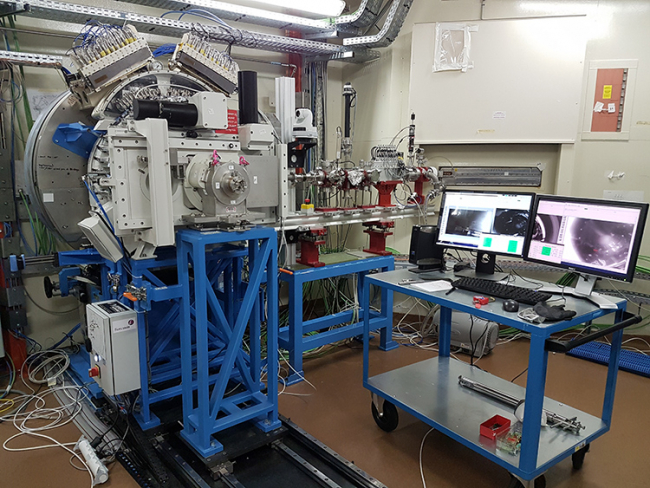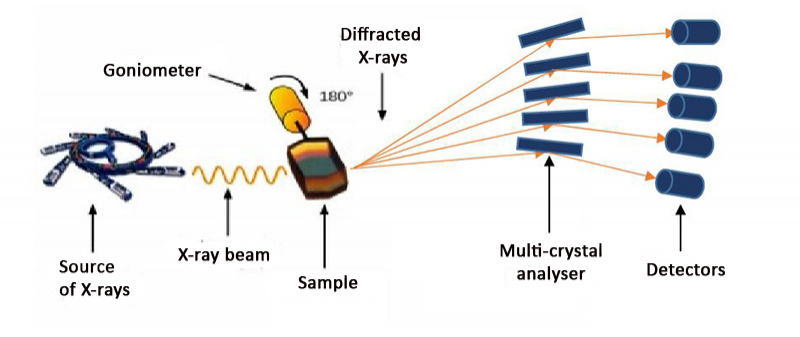Using X-ray diffraction, researchers of CEA and SOLEIL Synchrotron have just succeeded in characterising the microstructure of a nuclear fuel transverse section that had been irradiated in a reactor, an experiment that represents a global first and which started on Wednesday 21 November 2018.
This feat represents the fruits of a several-year scientific collaboration between CEA and SOLEIL to adapt one of the synchrotron beamlines for the receipt and handling of a section of nuclear fuel in its cladding. Hence, SOLEIL becomes the only synchrotron capable of receiving highly radioactive and contaminated solid samples, representative of an industrial object as used in French nuclear reactors.
The results obtained make it possible to improve the characterisation of irradiated nuclear fuel.
Starting on 21 November 2018, the first experiment anywhere in the world to characterise a solid sample of uranium oxide fuel, irradiated for 5 years in one of the reactors of the EDF Gravelines Nuclear Power Plant, uses High Resolution X-Ray diffraction (HR-XRD) and has been successfully under way on the MARS beamline of the SOLEIL synchrotron. The analysed object is a UO2 sample of several milligrams*, with a mean thickness of 50 µm. It represents a complete transverse section of a nuclear fuel rod as used in French pressurised water reactors: UO2 enriched to 4.48 % with 235U, irradiated in a reactor and cooled for 23 years. Until now, the only equipment available anywhere in the world was suitable for research into just a few grains of powder.

The sample is prepared from a fuel rod (1 cm diameter/4 metres long, left hand drawing), the researchers cut a section of the fuel (middle) and undertook various preparatory operations to achieve a platelet of a few milligrams with a thickness of 50 µm and a width of 1 mm. © CEA
The results will provide access to particularly detailed information on the structure and microstructure of the fuel and local changes from the centre to its outer diameter a fuel pellet (along the high temperature and burn-up gradient). Such characterisations will contribute to defining the physical mechanisms in play within the fuel so that they can be taken into account in modelling, and hence improve the prediction of changes in its behaviour when irradiated.
This X-ray diffraction characterisation on the synchrotron of the highly radioactive and contaminated solid fuel sample makes this experiment a global first.
A beamline adapted to accept radioactive materials
This success is the outcome of a collaboration between the teams of the CEA at Cadarache (Bouches-du-Rhône) and Saclay (Essonne) and SOLEIL (Essonne). Since the 2000s, the CEA has wanted, in order to fulfil its needs, to be able to exploit a ‘hot’ beamline on a synchrotron that is suitable for accepting radioactive and contaminated material. Since the construction of the synchrotron, the CEA and SOLEIL teams have invested and worked together to build and adapt the equipment of the MARS (“Multi-Analyses on Radioactive Samples”) beamline.

Photograph of the High-Resolution X-Ray Diffraction end-station with its additional shielding and the transportation cask docked © CEA/SOLEIL
Numerous steps were involved in achieving the goal:
- Design of a mobile biological protection module to transport and allow the docking of a radioactive sample on the analysis end-station of the MARS beamline without the users being exposed to radiation;
- Preparation of a solid fuel sample according to the required specifications;
- Obtaining of the authorisation of the French nuclear safety authority (ASN);
- Output of this solid sample from the hot laboratory (LECA-STAR) while complying with the radiological cleanliness criteria.
From X-ray diffraction to X-ray absorption spectroscopy
The MARS beamline is also operating a dedicated X-ray absorption end-station that the CEA and SOLEIL are adapting for its use with radioactive samples.

Reminder of the principle behind X-ray diffraction © CEA/SOLEIL
In the long term, SOLEIL, with its MARS beamline, will be the only synchrotron in the world to provide the capabilities required by the nuclear materials scientific community, amongst whom are the CEA teams who will have priority access to the MARS beam line because of the investments made in the equipment.
* Until now, the only equipment available anywhere in the world is suitable for research into just a few grains of powder. Therefore a sample of a few milligrams represents a massive sample for the scientists.
